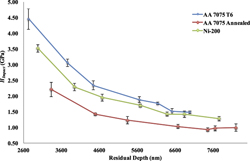Crossref Citations
This article has been cited by the following publications. This list is generated based on data provided by
Crossref.
Gao, Chenghui
and
Liu, Ming
2017.
Power law creep of polycarbonate by Berkovich nanoindentation.
Materials Research Express,
Vol. 4,
Issue. 10,
p.
105302.
Gao, Chenghui
Yao, Ligang
and
Liu, Ming
2018.
Berkovich nanoindentation of borosilicate K9 glass.
Optical Engineering,
Vol. 57,
Issue. 03,
p.
1.
Qin, Liguang
Li, Heng
Shi, Xiangru
Beake, Ben D.
Xiao, Lin
Smith, James F.
Sun, Zhengming
and
Chen, Jian
2019.
Investigation on dynamic hardness and high strain rate indentation size effects in aluminium (110) using nano-impact.
Mechanics of Materials,
Vol. 133,
Issue. ,
p.
55.
Boyce, Brad L.
and
Uchic, Michael D.
2019.
Progress toward autonomous experimental systems for alloy development.
MRS Bulletin,
Vol. 44,
Issue. 4,
p.
273.
Rueda-Ruiz, Mario
Beake, Ben D.
and
Molina-Aldareguia, Jon M.
2020.
New instrumentation and analysis methodology for nano-impact testing.
Materials & Design,
Vol. 192,
Issue. ,
p.
108715.
Shi, Xiangru
Li, Heng
Beake, Ben D.
Bao, Mingdong
Liskiewicz, Tomasz W.
Sun, Zhengming
and
Chen, Jian
2020.
Dynamic fracture of CrN coating by highly-resolved nano-impact.
Surface and Coatings Technology,
Vol. 383,
Issue. ,
p.
125288.
dos Santos, T.
and
Rodríguez-Martínez, J.A.
2021.
Size effects on the plastic shock formation in steady-state cavity expansion in porous ductile materials.
Mechanics Research Communications,
Vol. 113,
Issue. ,
p.
103690.
Shi, Xiangru
Chen, Jian
Beake, Ben D.
Liskiewicz, Tomasz W.
and
Wang, Zehua
2021.
Dynamic contact behavior of graphite-like carbon films on ductile substrate under nano/micro-scale impact.
Surface and Coatings Technology,
Vol. 422,
Issue. ,
p.
127515.
Sadyrin, Evgeniy V.
Nikolaev, Andrey L.
Bardakova, Regina A.
Kotova, Anzhelika A.
Kharchevnikov, Ivan O.
Zabiyaka, Igor Yu.
and
Aizikovich, Sergei M.
2023.
Deformation and Destruction of Materials and Structures Under Quasi-static and Impulse Loading.
Vol. 186,
Issue. ,
p.
245.
Wang, Kehua
Chen, Jian
Li, Yanhuai
Zhang, Xiyu
and
Beake, Ben.D.
2024.
Probing the small-scale impact deformation mechanism in an aluminum single-crystal.
Journal of Materials Science & Technology,
Vol. 187,
Issue. ,
p.
212.
Xiao, Jichang
Zhou, Qinghua
and
Wang, Jiaxu
2024.
Influence of δ Phase Microstructure Evolution on the Dynamic Nano-mechanical Properties of GH4169 Alloy.
Journal of Materials Engineering and Performance,
Shi, Xiangru
and
Chen, Jian
2025.
Nanomechanics for Coatings and Engineering Surfaces.
p.
239.
